Development Plan: Self-Managed Learning at Travelodge UK Agency
VerifiedAdded on 2024/06/03
|29
|4378
|382
Report
AI Summary
This report provides a comprehensive analysis of personal and professional development within the context of Travelodge UK. It begins with an evaluation of self-managed learning approaches, emphasizing lifelong learning and its benefits for both individuals and the organization. The report includes a self-assessment of current skills and competencies against professional standards, identifying development needs and outlining activities to meet them. A personal and professional development plan (PPD) is devised with specific objectives, followed by a discussion of the implementation process and documentation of development activities. The report also reflects critically on the learning process, updating the development plan based on feedback and evaluation. Furthermore, it addresses problem-solving in the workplace and effective communication strategies, concluding with an overview of time management approaches and their application in various situations.
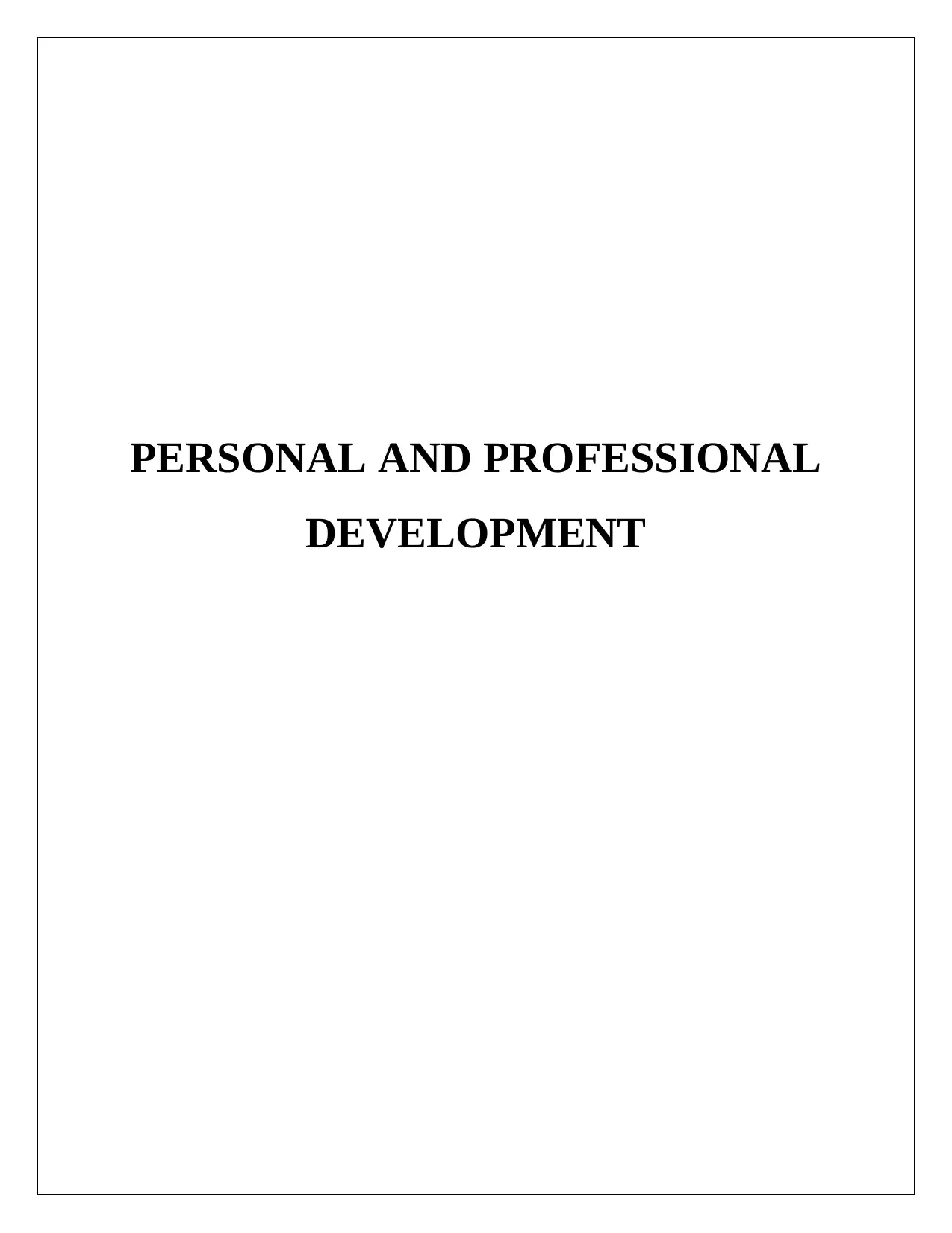
PERSONAL AND PROFESSIONAL
DEVELOPMENT
DEVELOPMENT
Paraphrase This Document
Need a fresh take? Get an instant paraphrase of this document with our AI Paraphraser
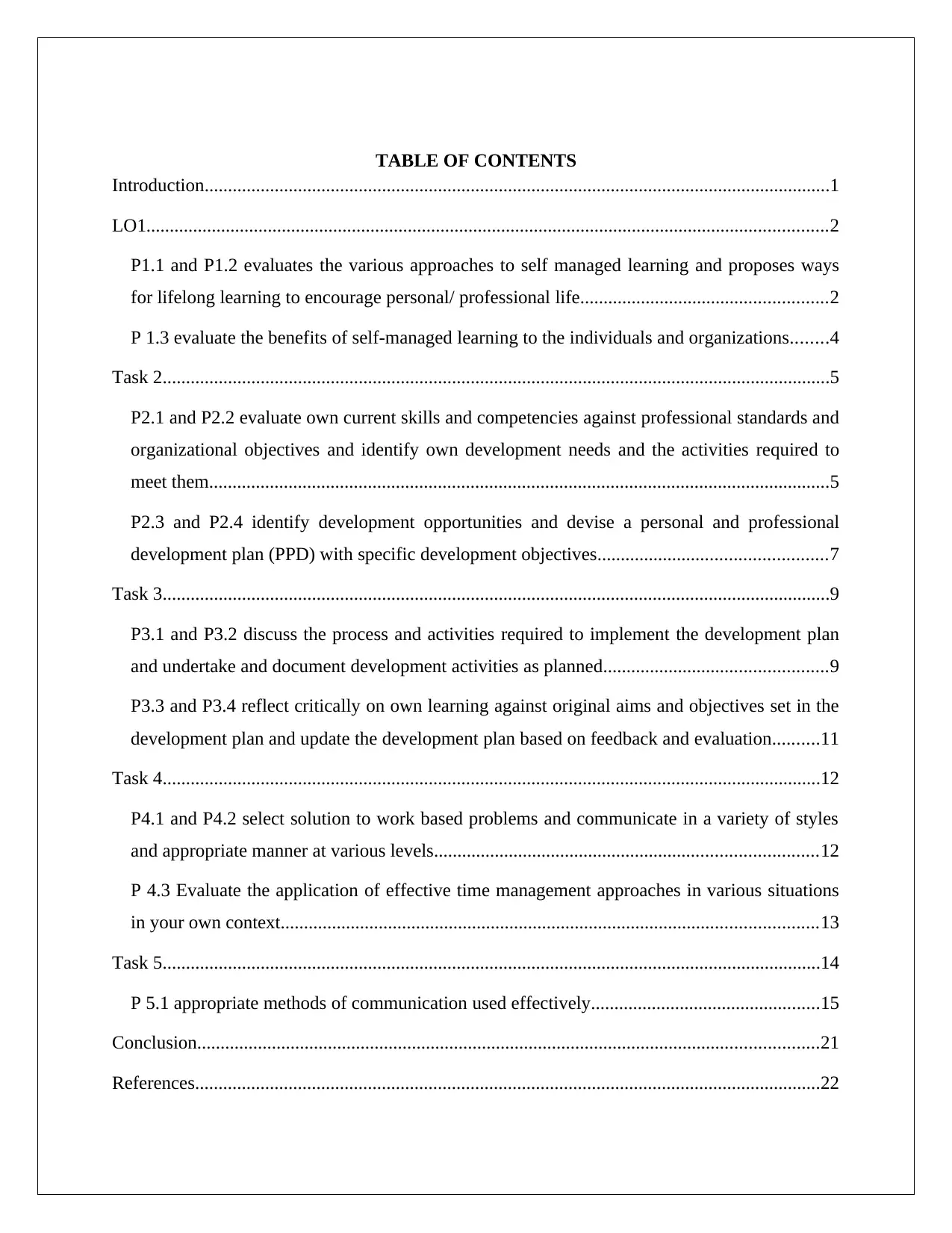
TABLE OF CONTENTS
Introduction......................................................................................................................................1
LO1..................................................................................................................................................2
P1.1 and P1.2 evaluates the various approaches to self managed learning and proposes ways
for lifelong learning to encourage personal/ professional life.....................................................2
P 1.3 evaluate the benefits of self-managed learning to the individuals and organizations........4
Task 2...............................................................................................................................................5
P2.1 and P2.2 evaluate own current skills and competencies against professional standards and
organizational objectives and identify own development needs and the activities required to
meet them.....................................................................................................................................5
P2.3 and P2.4 identify development opportunities and devise a personal and professional
development plan (PPD) with specific development objectives.................................................7
Task 3...............................................................................................................................................9
P3.1 and P3.2 discuss the process and activities required to implement the development plan
and undertake and document development activities as planned................................................9
P3.3 and P3.4 reflect critically on own learning against original aims and objectives set in the
development plan and update the development plan based on feedback and evaluation..........11
Task 4.............................................................................................................................................12
P4.1 and P4.2 select solution to work based problems and communicate in a variety of styles
and appropriate manner at various levels..................................................................................12
P 4.3 Evaluate the application of effective time management approaches in various situations
in your own context...................................................................................................................13
Task 5.............................................................................................................................................14
P 5.1 appropriate methods of communication used effectively.................................................15
Conclusion.....................................................................................................................................21
References......................................................................................................................................22
Introduction......................................................................................................................................1
LO1..................................................................................................................................................2
P1.1 and P1.2 evaluates the various approaches to self managed learning and proposes ways
for lifelong learning to encourage personal/ professional life.....................................................2
P 1.3 evaluate the benefits of self-managed learning to the individuals and organizations........4
Task 2...............................................................................................................................................5
P2.1 and P2.2 evaluate own current skills and competencies against professional standards and
organizational objectives and identify own development needs and the activities required to
meet them.....................................................................................................................................5
P2.3 and P2.4 identify development opportunities and devise a personal and professional
development plan (PPD) with specific development objectives.................................................7
Task 3...............................................................................................................................................9
P3.1 and P3.2 discuss the process and activities required to implement the development plan
and undertake and document development activities as planned................................................9
P3.3 and P3.4 reflect critically on own learning against original aims and objectives set in the
development plan and update the development plan based on feedback and evaluation..........11
Task 4.............................................................................................................................................12
P4.1 and P4.2 select solution to work based problems and communicate in a variety of styles
and appropriate manner at various levels..................................................................................12
P 4.3 Evaluate the application of effective time management approaches in various situations
in your own context...................................................................................................................13
Task 5.............................................................................................................................................14
P 5.1 appropriate methods of communication used effectively.................................................15
Conclusion.....................................................................................................................................21
References......................................................................................................................................22

⊘ This is a preview!⊘
Do you want full access?
Subscribe today to unlock all pages.

Trusted by 1+ million students worldwide
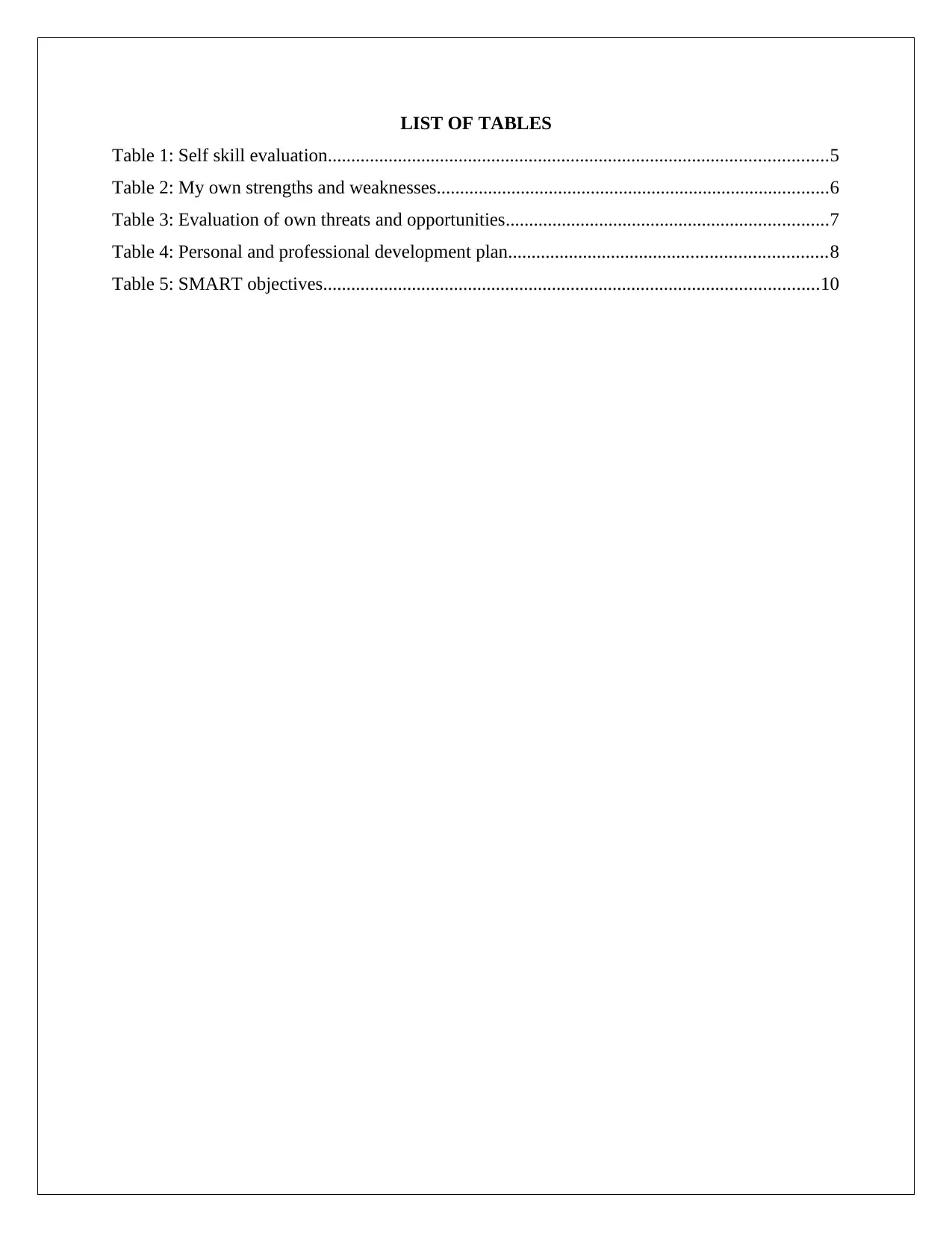
LIST OF TABLES
Table 1: Self skill evaluation...........................................................................................................5
Table 2: My own strengths and weaknesses....................................................................................6
Table 3: Evaluation of own threats and opportunities.....................................................................7
Table 4: Personal and professional development plan....................................................................8
Table 5: SMART objectives..........................................................................................................10
Table 1: Self skill evaluation...........................................................................................................5
Table 2: My own strengths and weaknesses....................................................................................6
Table 3: Evaluation of own threats and opportunities.....................................................................7
Table 4: Personal and professional development plan....................................................................8
Table 5: SMART objectives..........................................................................................................10
Paraphrase This Document
Need a fresh take? Get an instant paraphrase of this document with our AI Paraphraser
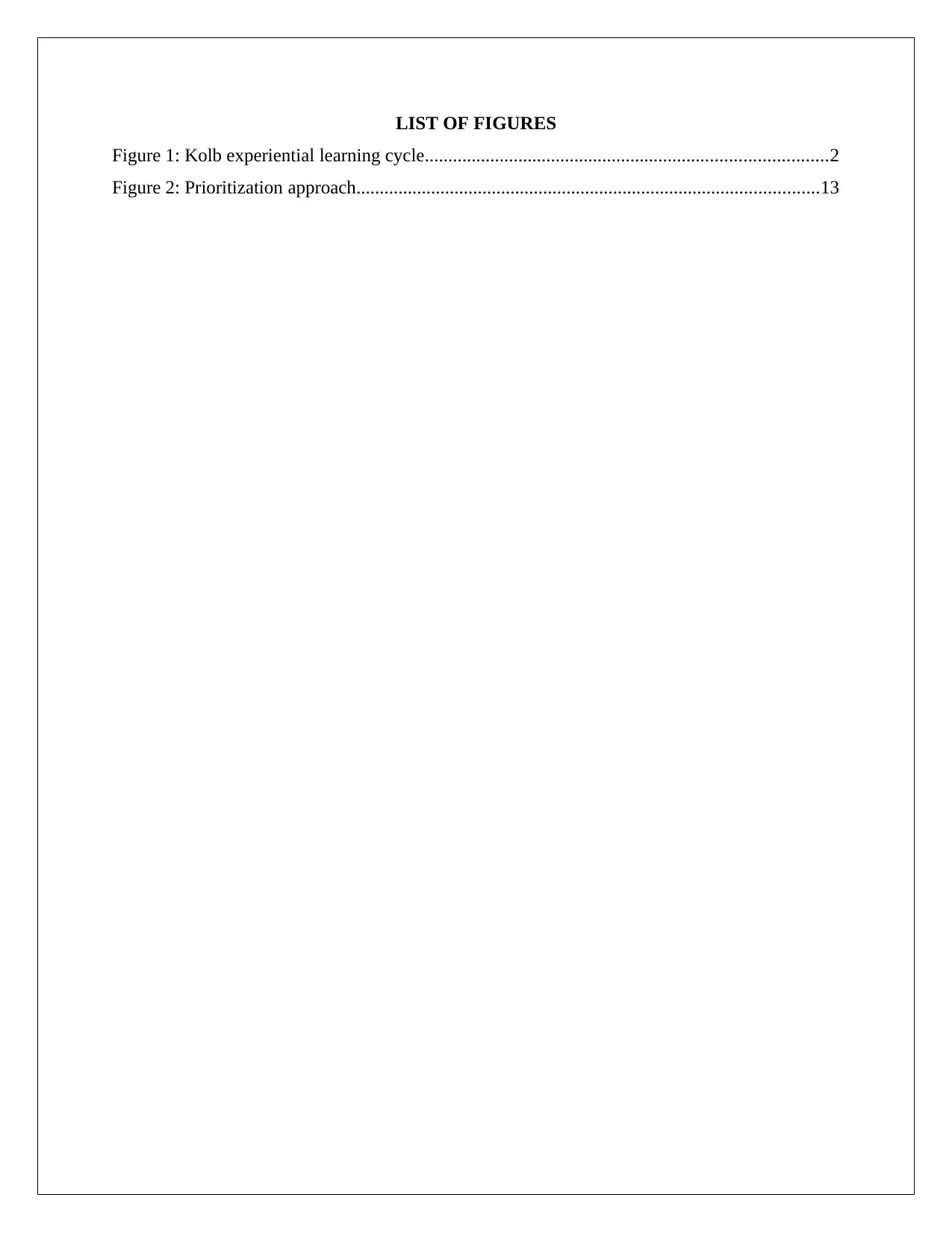
LIST OF FIGURES
Figure 1: Kolb experiential learning cycle......................................................................................2
Figure 2: Prioritization approach...................................................................................................13
Figure 1: Kolb experiential learning cycle......................................................................................2
Figure 2: Prioritization approach...................................................................................................13
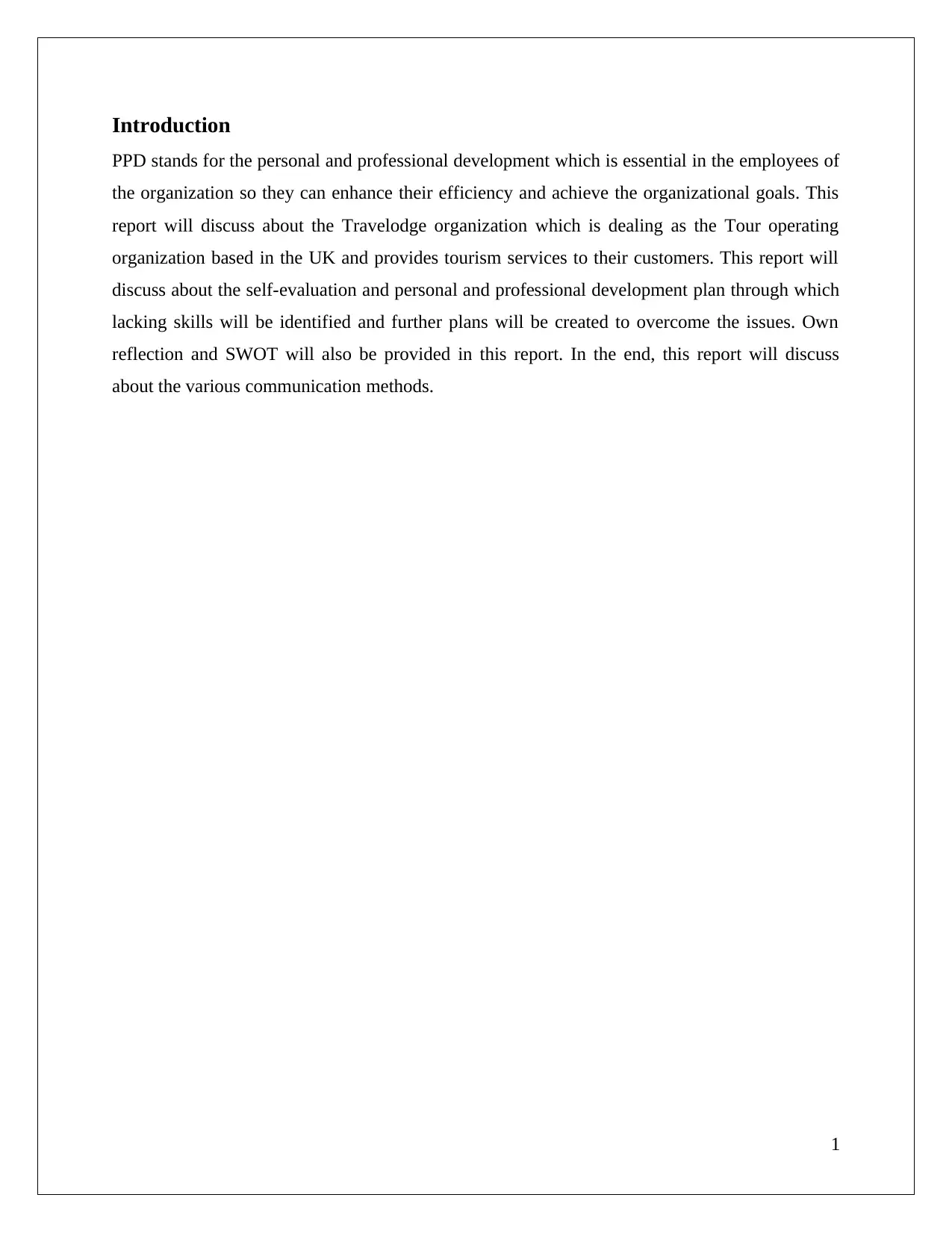
Introduction
PPD stands for the personal and professional development which is essential in the employees of
the organization so they can enhance their efficiency and achieve the organizational goals. This
report will discuss about the Travelodge organization which is dealing as the Tour operating
organization based in the UK and provides tourism services to their customers. This report will
discuss about the self-evaluation and personal and professional development plan through which
lacking skills will be identified and further plans will be created to overcome the issues. Own
reflection and SWOT will also be provided in this report. In the end, this report will discuss
about the various communication methods.
1
PPD stands for the personal and professional development which is essential in the employees of
the organization so they can enhance their efficiency and achieve the organizational goals. This
report will discuss about the Travelodge organization which is dealing as the Tour operating
organization based in the UK and provides tourism services to their customers. This report will
discuss about the self-evaluation and personal and professional development plan through which
lacking skills will be identified and further plans will be created to overcome the issues. Own
reflection and SWOT will also be provided in this report. In the end, this report will discuss
about the various communication methods.
1
⊘ This is a preview!⊘
Do you want full access?
Subscribe today to unlock all pages.

Trusted by 1+ million students worldwide
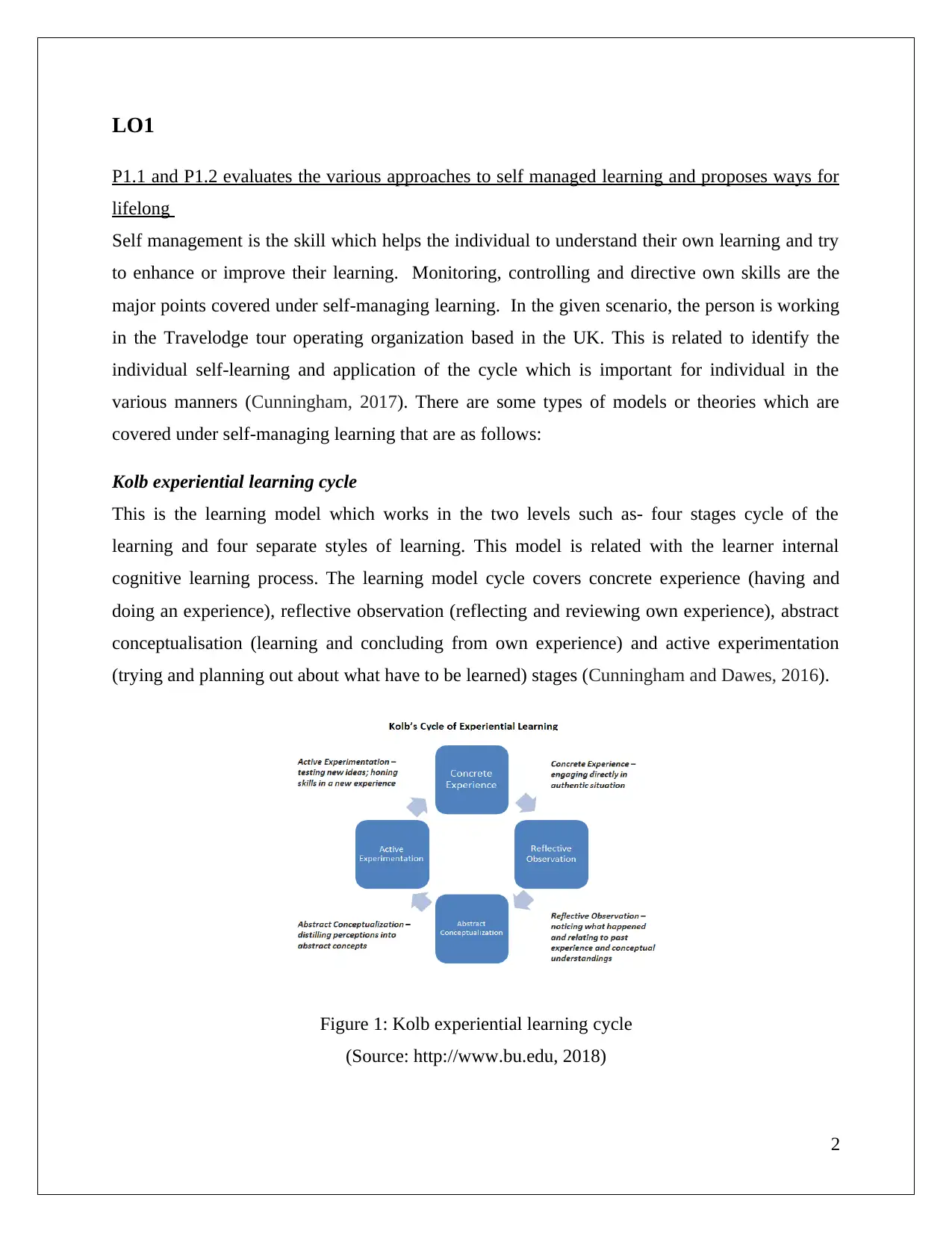
LO1
P1.1 and P1.2 evaluates the various approaches to self managed learning and proposes ways for
lifelong
Self management is the skill which helps the individual to understand their own learning and try
to enhance or improve their learning. Monitoring, controlling and directive own skills are the
major points covered under self-managing learning. In the given scenario, the person is working
in the Travelodge tour operating organization based in the UK. This is related to identify the
individual self-learning and application of the cycle which is important for individual in the
various manners (Cunningham, 2017). There are some types of models or theories which are
covered under self-managing learning that are as follows:
Kolb experiential learning cycle
This is the learning model which works in the two levels such as- four stages cycle of the
learning and four separate styles of learning. This model is related with the learner internal
cognitive learning process. The learning model cycle covers concrete experience (having and
doing an experience), reflective observation (reflecting and reviewing own experience), abstract
conceptualisation (learning and concluding from own experience) and active experimentation
(trying and planning out about what have to be learned) stages (Cunningham and Dawes, 2016).
Figure 1: Kolb experiential learning cycle
(Source: http://www.bu.edu, 2018)
2
P1.1 and P1.2 evaluates the various approaches to self managed learning and proposes ways for
lifelong
Self management is the skill which helps the individual to understand their own learning and try
to enhance or improve their learning. Monitoring, controlling and directive own skills are the
major points covered under self-managing learning. In the given scenario, the person is working
in the Travelodge tour operating organization based in the UK. This is related to identify the
individual self-learning and application of the cycle which is important for individual in the
various manners (Cunningham, 2017). There are some types of models or theories which are
covered under self-managing learning that are as follows:
Kolb experiential learning cycle
This is the learning model which works in the two levels such as- four stages cycle of the
learning and four separate styles of learning. This model is related with the learner internal
cognitive learning process. The learning model cycle covers concrete experience (having and
doing an experience), reflective observation (reflecting and reviewing own experience), abstract
conceptualisation (learning and concluding from own experience) and active experimentation
(trying and planning out about what have to be learned) stages (Cunningham and Dawes, 2016).
Figure 1: Kolb experiential learning cycle
(Source: http://www.bu.edu, 2018)
2
Paraphrase This Document
Need a fresh take? Get an instant paraphrase of this document with our AI Paraphraser
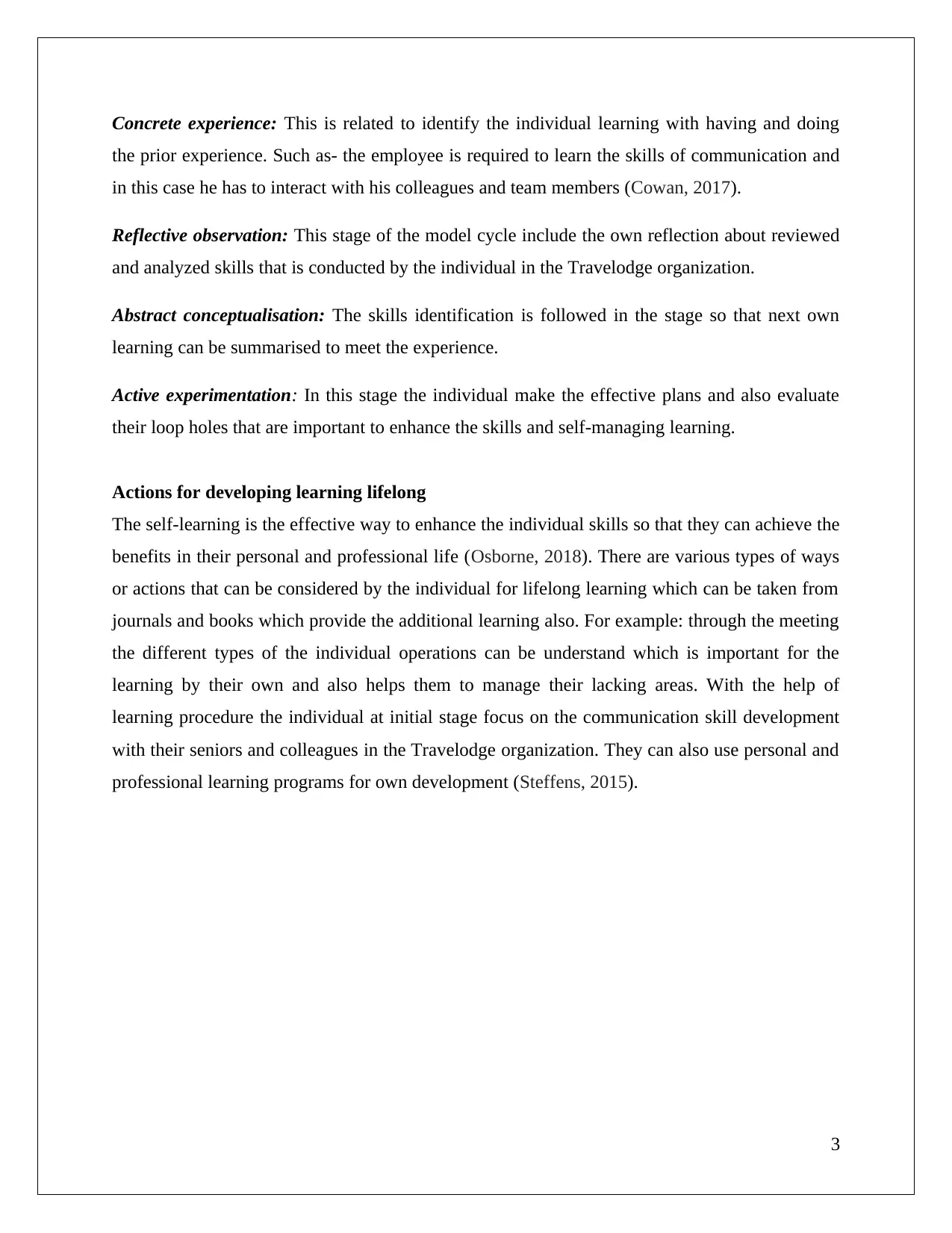
Concrete experience: This is related to identify the individual learning with having and doing
the prior experience. Such as- the employee is required to learn the skills of communication and
in this case he has to interact with his colleagues and team members (Cowan, 2017).
Reflective observation: This stage of the model cycle include the own reflection about reviewed
and analyzed skills that is conducted by the individual in the Travelodge organization.
Abstract conceptualisation: The skills identification is followed in the stage so that next own
learning can be summarised to meet the experience.
Active experimentation: In this stage the individual make the effective plans and also evaluate
their loop holes that are important to enhance the skills and self-managing learning.
Actions for developing learning lifelong
The self-learning is the effective way to enhance the individual skills so that they can achieve the
benefits in their personal and professional life (Osborne, 2018). There are various types of ways
or actions that can be considered by the individual for lifelong learning which can be taken from
journals and books which provide the additional learning also. For example: through the meeting
the different types of the individual operations can be understand which is important for the
learning by their own and also helps them to manage their lacking areas. With the help of
learning procedure the individual at initial stage focus on the communication skill development
with their seniors and colleagues in the Travelodge organization. They can also use personal and
professional learning programs for own development (Steffens, 2015).
3
the prior experience. Such as- the employee is required to learn the skills of communication and
in this case he has to interact with his colleagues and team members (Cowan, 2017).
Reflective observation: This stage of the model cycle include the own reflection about reviewed
and analyzed skills that is conducted by the individual in the Travelodge organization.
Abstract conceptualisation: The skills identification is followed in the stage so that next own
learning can be summarised to meet the experience.
Active experimentation: In this stage the individual make the effective plans and also evaluate
their loop holes that are important to enhance the skills and self-managing learning.
Actions for developing learning lifelong
The self-learning is the effective way to enhance the individual skills so that they can achieve the
benefits in their personal and professional life (Osborne, 2018). There are various types of ways
or actions that can be considered by the individual for lifelong learning which can be taken from
journals and books which provide the additional learning also. For example: through the meeting
the different types of the individual operations can be understand which is important for the
learning by their own and also helps them to manage their lacking areas. With the help of
learning procedure the individual at initial stage focus on the communication skill development
with their seniors and colleagues in the Travelodge organization. They can also use personal and
professional learning programs for own development (Steffens, 2015).
3
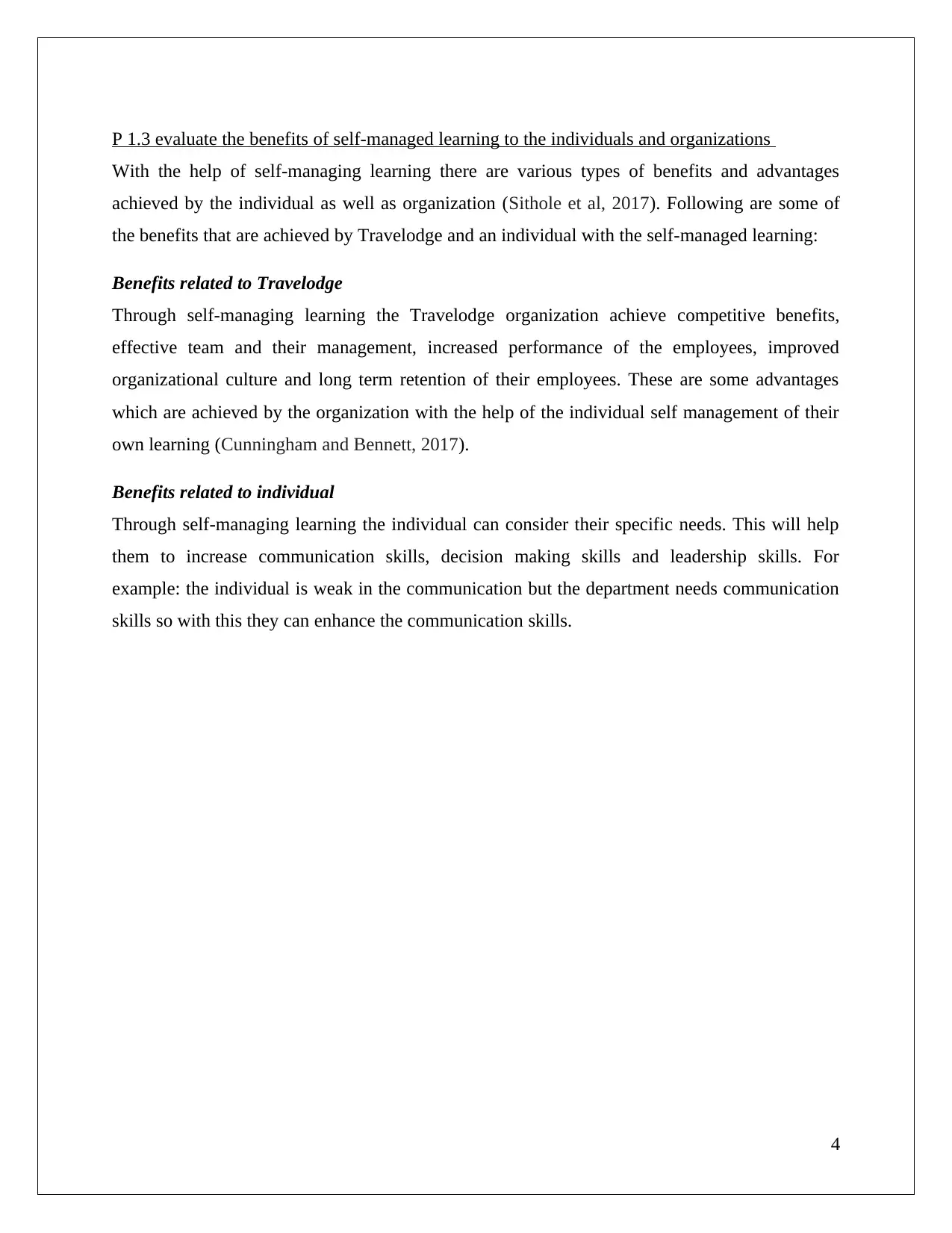
P 1.3 evaluate the benefits of self-managed learning to the individuals and organizations
With the help of self-managing learning there are various types of benefits and advantages
achieved by the individual as well as organization (Sithole et al, 2017). Following are some of
the benefits that are achieved by Travelodge and an individual with the self-managed learning:
Benefits related to Travelodge
Through self-managing learning the Travelodge organization achieve competitive benefits,
effective team and their management, increased performance of the employees, improved
organizational culture and long term retention of their employees. These are some advantages
which are achieved by the organization with the help of the individual self management of their
own learning (Cunningham and Bennett, 2017).
Benefits related to individual
Through self-managing learning the individual can consider their specific needs. This will help
them to increase communication skills, decision making skills and leadership skills. For
example: the individual is weak in the communication but the department needs communication
skills so with this they can enhance the communication skills.
4
With the help of self-managing learning there are various types of benefits and advantages
achieved by the individual as well as organization (Sithole et al, 2017). Following are some of
the benefits that are achieved by Travelodge and an individual with the self-managed learning:
Benefits related to Travelodge
Through self-managing learning the Travelodge organization achieve competitive benefits,
effective team and their management, increased performance of the employees, improved
organizational culture and long term retention of their employees. These are some advantages
which are achieved by the organization with the help of the individual self management of their
own learning (Cunningham and Bennett, 2017).
Benefits related to individual
Through self-managing learning the individual can consider their specific needs. This will help
them to increase communication skills, decision making skills and leadership skills. For
example: the individual is weak in the communication but the department needs communication
skills so with this they can enhance the communication skills.
4
⊘ This is a preview!⊘
Do you want full access?
Subscribe today to unlock all pages.

Trusted by 1+ million students worldwide
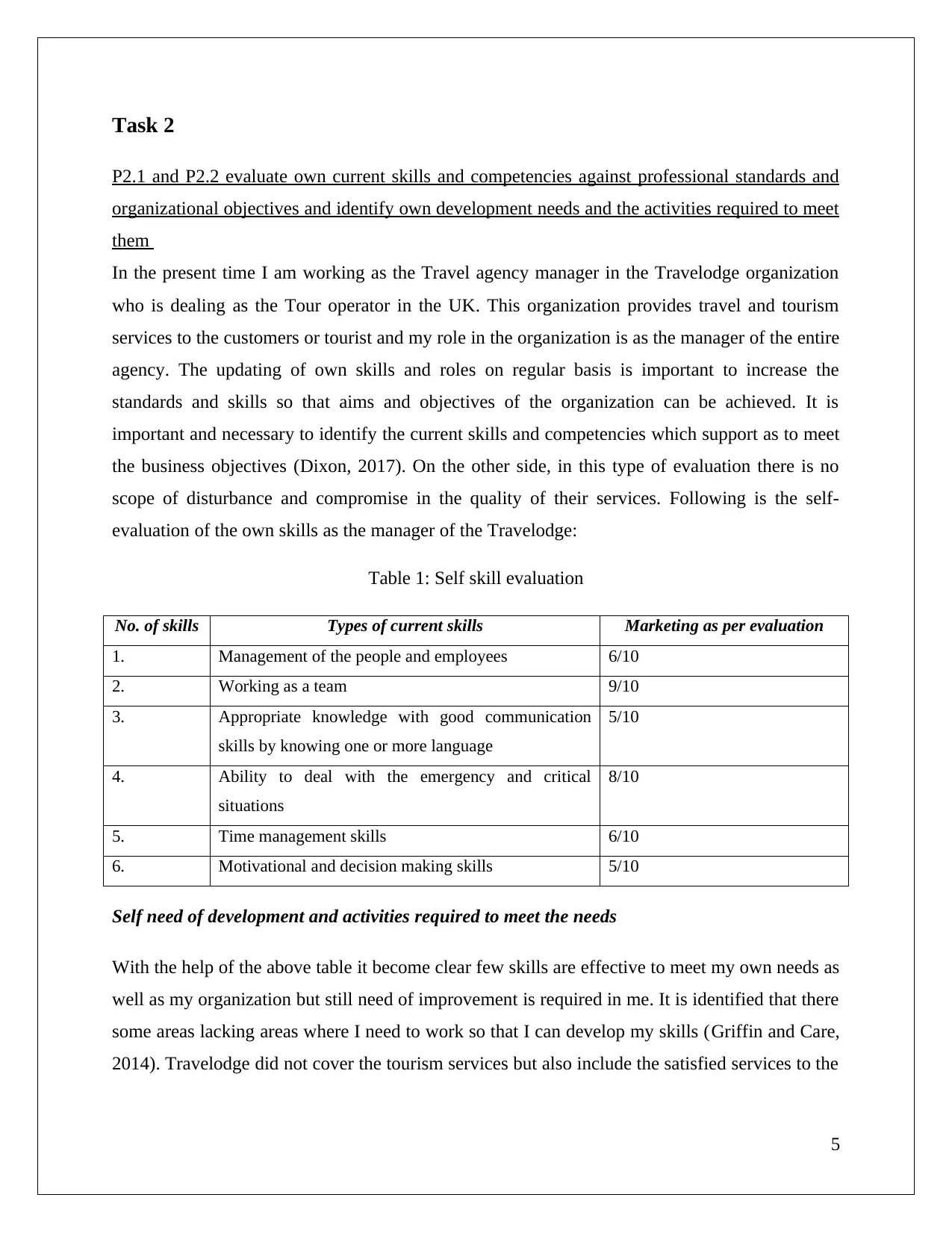
Task 2
P2.1 and P2.2 evaluate own current skills and competencies against professional standards and
organizational objectives and identify own development needs and the activities required to meet
them
In the present time I am working as the Travel agency manager in the Travelodge organization
who is dealing as the Tour operator in the UK. This organization provides travel and tourism
services to the customers or tourist and my role in the organization is as the manager of the entire
agency. The updating of own skills and roles on regular basis is important to increase the
standards and skills so that aims and objectives of the organization can be achieved. It is
important and necessary to identify the current skills and competencies which support as to meet
the business objectives (Dixon, 2017). On the other side, in this type of evaluation there is no
scope of disturbance and compromise in the quality of their services. Following is the self-
evaluation of the own skills as the manager of the Travelodge:
Table 1: Self skill evaluation
No. of skills Types of current skills Marketing as per evaluation
1. Management of the people and employees 6/10
2. Working as a team 9/10
3. Appropriate knowledge with good communication
skills by knowing one or more language
5/10
4. Ability to deal with the emergency and critical
situations
8/10
5. Time management skills 6/10
6. Motivational and decision making skills 5/10
Self need of development and activities required to meet the needs
With the help of the above table it become clear few skills are effective to meet my own needs as
well as my organization but still need of improvement is required in me. It is identified that there
some areas lacking areas where I need to work so that I can develop my skills (Griffin and Care,
2014). Travelodge did not cover the tourism services but also include the satisfied services to the
5
P2.1 and P2.2 evaluate own current skills and competencies against professional standards and
organizational objectives and identify own development needs and the activities required to meet
them
In the present time I am working as the Travel agency manager in the Travelodge organization
who is dealing as the Tour operator in the UK. This organization provides travel and tourism
services to the customers or tourist and my role in the organization is as the manager of the entire
agency. The updating of own skills and roles on regular basis is important to increase the
standards and skills so that aims and objectives of the organization can be achieved. It is
important and necessary to identify the current skills and competencies which support as to meet
the business objectives (Dixon, 2017). On the other side, in this type of evaluation there is no
scope of disturbance and compromise in the quality of their services. Following is the self-
evaluation of the own skills as the manager of the Travelodge:
Table 1: Self skill evaluation
No. of skills Types of current skills Marketing as per evaluation
1. Management of the people and employees 6/10
2. Working as a team 9/10
3. Appropriate knowledge with good communication
skills by knowing one or more language
5/10
4. Ability to deal with the emergency and critical
situations
8/10
5. Time management skills 6/10
6. Motivational and decision making skills 5/10
Self need of development and activities required to meet the needs
With the help of the above table it become clear few skills are effective to meet my own needs as
well as my organization but still need of improvement is required in me. It is identified that there
some areas lacking areas where I need to work so that I can develop my skills (Griffin and Care,
2014). Travelodge did not cover the tourism services but also include the satisfied services to the
5
Paraphrase This Document
Need a fresh take? Get an instant paraphrase of this document with our AI Paraphraser
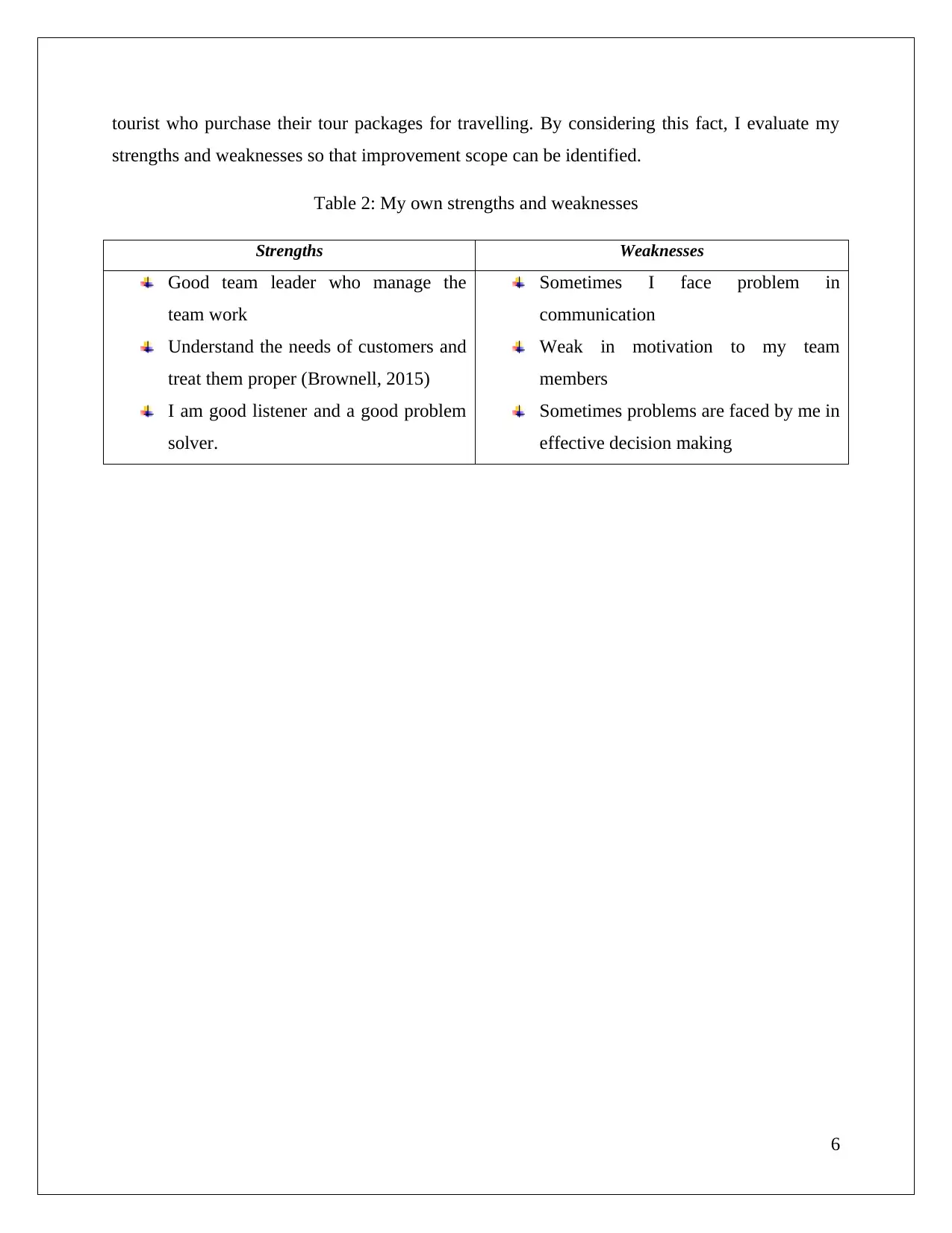
tourist who purchase their tour packages for travelling. By considering this fact, I evaluate my
strengths and weaknesses so that improvement scope can be identified.
Table 2: My own strengths and weaknesses
Strengths Weaknesses
Good team leader who manage the
team work
Understand the needs of customers and
treat them proper (Brownell, 2015)
I am good listener and a good problem
solver.
Sometimes I face problem in
communication
Weak in motivation to my team
members
Sometimes problems are faced by me in
effective decision making
6
strengths and weaknesses so that improvement scope can be identified.
Table 2: My own strengths and weaknesses
Strengths Weaknesses
Good team leader who manage the
team work
Understand the needs of customers and
treat them proper (Brownell, 2015)
I am good listener and a good problem
solver.
Sometimes I face problem in
communication
Weak in motivation to my team
members
Sometimes problems are faced by me in
effective decision making
6
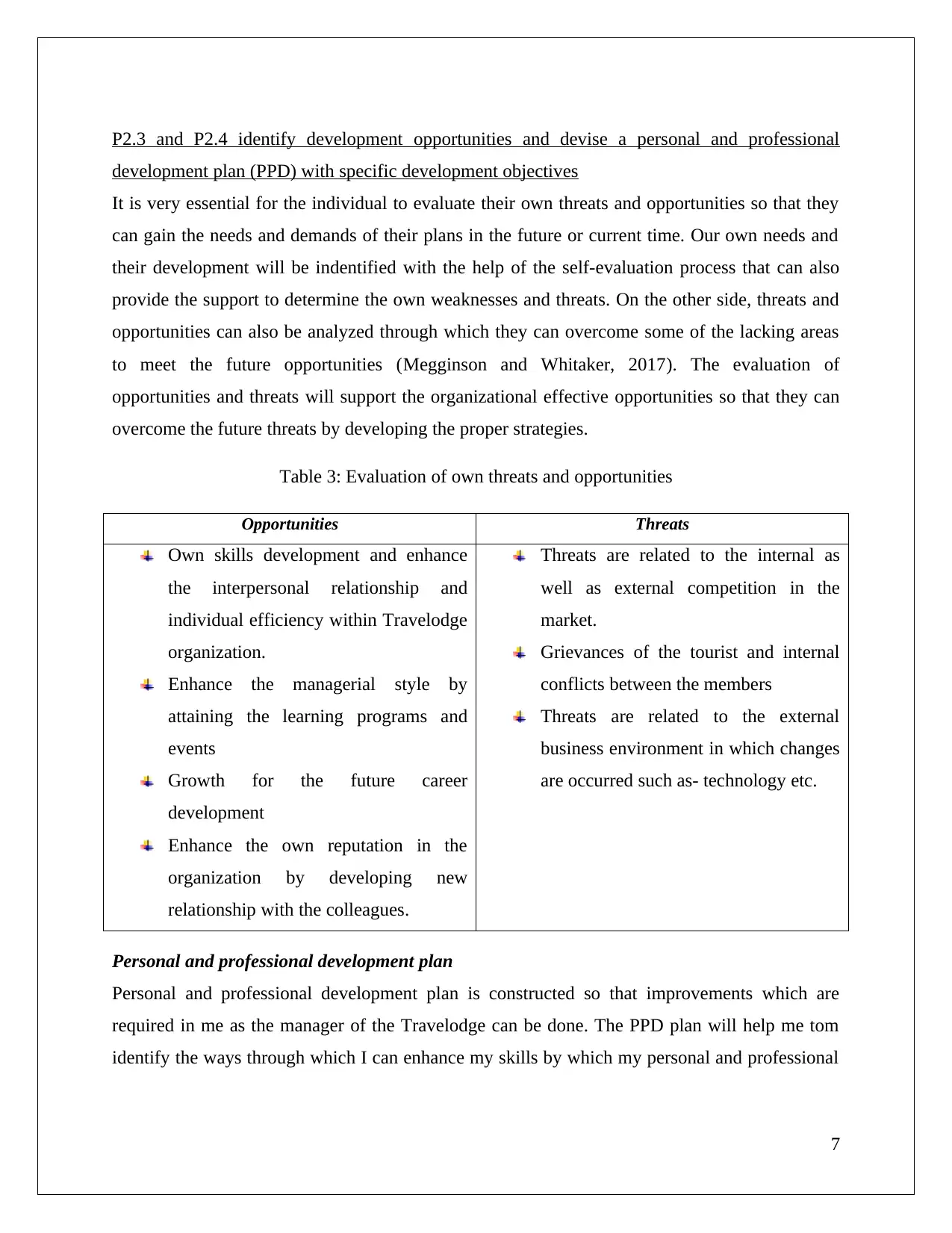
P2.3 and P2.4 identify development opportunities and devise a personal and professional
development plan (PPD) with specific development objectives
It is very essential for the individual to evaluate their own threats and opportunities so that they
can gain the needs and demands of their plans in the future or current time. Our own needs and
their development will be indentified with the help of the self-evaluation process that can also
provide the support to determine the own weaknesses and threats. On the other side, threats and
opportunities can also be analyzed through which they can overcome some of the lacking areas
to meet the future opportunities (Megginson and Whitaker, 2017). The evaluation of
opportunities and threats will support the organizational effective opportunities so that they can
overcome the future threats by developing the proper strategies.
Table 3: Evaluation of own threats and opportunities
Opportunities Threats
Own skills development and enhance
the interpersonal relationship and
individual efficiency within Travelodge
organization.
Enhance the managerial style by
attaining the learning programs and
events
Growth for the future career
development
Enhance the own reputation in the
organization by developing new
relationship with the colleagues.
Threats are related to the internal as
well as external competition in the
market.
Grievances of the tourist and internal
conflicts between the members
Threats are related to the external
business environment in which changes
are occurred such as- technology etc.
Personal and professional development plan
Personal and professional development plan is constructed so that improvements which are
required in me as the manager of the Travelodge can be done. The PPD plan will help me tom
identify the ways through which I can enhance my skills by which my personal and professional
7
development plan (PPD) with specific development objectives
It is very essential for the individual to evaluate their own threats and opportunities so that they
can gain the needs and demands of their plans in the future or current time. Our own needs and
their development will be indentified with the help of the self-evaluation process that can also
provide the support to determine the own weaknesses and threats. On the other side, threats and
opportunities can also be analyzed through which they can overcome some of the lacking areas
to meet the future opportunities (Megginson and Whitaker, 2017). The evaluation of
opportunities and threats will support the organizational effective opportunities so that they can
overcome the future threats by developing the proper strategies.
Table 3: Evaluation of own threats and opportunities
Opportunities Threats
Own skills development and enhance
the interpersonal relationship and
individual efficiency within Travelodge
organization.
Enhance the managerial style by
attaining the learning programs and
events
Growth for the future career
development
Enhance the own reputation in the
organization by developing new
relationship with the colleagues.
Threats are related to the internal as
well as external competition in the
market.
Grievances of the tourist and internal
conflicts between the members
Threats are related to the external
business environment in which changes
are occurred such as- technology etc.
Personal and professional development plan
Personal and professional development plan is constructed so that improvements which are
required in me as the manager of the Travelodge can be done. The PPD plan will help me tom
identify the ways through which I can enhance my skills by which my personal and professional
7
⊘ This is a preview!⊘
Do you want full access?
Subscribe today to unlock all pages.

Trusted by 1+ million students worldwide
1 out of 29
Related Documents
Your All-in-One AI-Powered Toolkit for Academic Success.
+13062052269
info@desklib.com
Available 24*7 on WhatsApp / Email
![[object Object]](/_next/static/media/star-bottom.7253800d.svg)
Unlock your academic potential
Copyright © 2020–2025 A2Z Services. All Rights Reserved. Developed and managed by ZUCOL.
